KITCHEN DESIGN - COUNTERTOPS

Granite schmanet…enough already.
In the early 80’s granite kitchen counters went freekin' viral. No one wanted anything else… houses were sold with the tagline “granite kitchen” (much like today’s “stainless kitchen”). Then, just like anything else people got tired of the limited palette of grays, gold’s, rust's and blacks that granite offered and ventured into other stone materials. Now, the hottest stone in traditional kitchens is Calacatta Gold because everyone thinks it’s timeless….riiiight...
In my own home in Florida I cook often and I love my kitchen to have a super clean "laboratory" look - everything dead-white. So I used pure white Greek Thassos marble, a dead-white stone which has a slightly crystalized look. Thassos is stunning to look at, but it chips, stains and is hard to keep clean. I'd rather have white quartz now.
In my own home in Florida I cook often and I love my kitchen to have a super clean "laboratory" look - everything dead-white. So I used pure white Greek Thassos marble, a dead-white stone which has a slightly crystalized look. Thassos is stunning to look at, but it chips, stains and is hard to keep clean. I'd rather have white quartz now.
As far as timelessness goes, the only countertop material that is truly timeless is stainless steel, it’s been used since the 1890’s and lasts forever, and the “style” never changes.
QUARRIED STONE

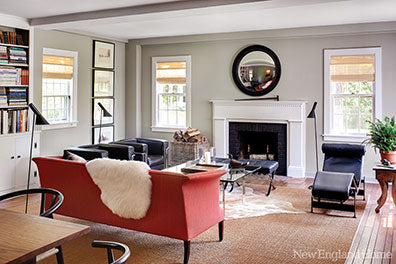
GOOD QUALITIES:
- Hardest of the countertop materials, extremely durable
- Can be honed, softly-textured, flamed or polished
- Seams together better than marble, almost invisibly
- Keeps shine indefinitely
- Totally heat resistant
- Can cut, chop, pulverize on it
- Can be cooled with special element for pastry making
- Hides crumbs and dust flecks
- OK for direct contact with food
- Can have many integral details like trash chutes, drain boards
- Can have integral sinks made of same material
- Impervious to everything
- OK for stove spatters and standing water
- Fairly limited color range, locks in a color scheme/range forever
- Costs more to cut and apply decorative edges and cutouts
- Always cold to the touch
- More breakage on china and glassware
- Reflects under-cabinet lights when highly polished
- Noise reflecting
- Needs sealing annually
- Expensive
JPD: Granite will last forever, which can be a good thing and a bad thing....it comes in a large variety of colors but most are boring, and the pretty ones are more expensive....imagine that.. It also has a commercial look like a bank or office building facade. It needs to be carefully used as a large island can look like the top of a burial vault. Personally, I find it dated looking unless you use the honed or flamed finishes.
MARBLE: $$$

GOOD QUALITIES:
- Endless color and pattern choices
- Can be polished, honed or softly-textured
- Less expensive to cut and apply decorative edges
- Totally heat resistant
- Can cut, chop, pulverize on it - but it scratches
- Can be cooled with special element for pastry making
- Charming when left unsealed and becomes patinated
- Durable
- OK for direct contact with food
- Can have many integral details like trash chutes and drain boards
- OK for stove spatters and standing water
- Hides crumbs and dust flecks
BAD QUALITIES:
- Softer stone than granite, will scratch
- Stains occasionally from long standing spills (wine, oils, etc.)
- Needs sealing every year
- Harder to find with acceptable veining
- Can chip on sharp edges if knocked hard
- Needs to be re-polished every few years if bright shine is desired
- Will become less shiny in high-use areas
- Will etch from citrus and acidic foods
- Specific colors lock in a color scheme forever
- More breakage with china and glassware
- Reflects under-cabinet lights when highly polished
- Noise reflecting
- Harder to match because of veining
- Stains easily from stove-top spatters when not sealed
JPD: Can be absolutely stunning in traditional or contemporary settings; once it acquires a patina (scratched, worn and slightly stained) I think it's even more attractive, really! Requires some maintenance if you want a perfect look all the time. It is more elegant than granite and has an appearance of quality. Personally, I don’t like to work on something that feels cold all the time, especially the winter. Be careful when using highly patterned stones it can make some kitchens look busy or cluttered.

GOOD QUALITIES:
- Portrays old fashioned look
- Has a silky feel to the hand
- Acquires patina quickly
- Seams together well
- Totally heat resistant
- Can cut, chop, pulverize on it - but it scratches
- Can be cooled with special element for pastry making
- Hides crumbs and dust flecks
- Extremely durable
- OK for direct contact with food
- Can have integral details like trash chutes, drain boards
- Tolerates standing water
- Very soft (porous) and scratches easily
- Very limited color palette of greens and grays
- Needs oiling fairly often
- Stains and becomes patinated when not oiled
- Only in matte or low-lustre finish
- Stains easily from stove-top spatters when not cleaned up quickly
LIMESTONE: $$$


GOOD QUALITIES:
- Has numerous soft colors in the palette
- Good for contemporary and traditional kitchens
- Subtle patterns
- Can be honed, polished or textured
- Becomes patinated quickly when not sealed
- Seams together well
- Totally heat resistant
- Can cut, chop, pulverize on it
- Hides crumbs and dust flecks
- Fairly durable
- OK for direct contact with food
- Can have many integral details like trash chutes, drain boards
- Tolerates standing water
- Very soft
- Needs sealing annually
- Etches easily from food, citrus, red wine, acidic foods
- Noise reflecting
- More breakage on china and glassware
- Very limited color palette; vanilla, grays and beige's
- Stains and easily becomes patinated when unsealed
- Best in matte or bead-blasted finish
- Can stain from stove-top spatters when not sealed
NATURAL WOOD

For a sampling of wooden products: Devos Working
Wood tops should not be Polyurethaned or shellacked. Polyurethane will become sticky/tacky over time and dirt and food particles will become attached. Shellac is an organic material and will breakdown when in contact with food.

For a sampling of wooden products: Devos Working
Wood tops should not be Polyurethaned or shellacked. Polyurethane will become sticky/tacky over time and dirt and food particles will become attached. Shellac is an organic material and will breakdown when in contact with food.
MAPLE CHOPPING BLOCK $$ - $$$

GOOD QUALITIES:
- Soft to the touch
- Always temperate
- Chop, cut and pulverize on it
- Seams together well
- Heat resistant
- Hides crumbs and dust flecks
- Extremely durable
- Looks chic when used in specific areas
- Good for “period” style kitchens
- Can have small issues sanded out
- OK for direct contact with food - if kept clean
- Can have integral details like trash chutes and drain boards
- If not cleaned properly can retain bacteria
- Will stain
- Needs oiling occasionally
- Always looks dusty
- Cannot be resin-sealed
- Looks outdated when not used properly
- Stains easily from stove-top spatters
MAHOGANY $ - $$

GOOD QUALITIES:
- Looks very elegant
- Maintains beautiful color when oiled
- Less expensive than most
- Coordinates with other mahogany accents, furniture, floors, etc.
- Can be resin-sealed
- Feels good to the touch
- Temperate
- Dense durable wood
- Nice on bars or in butler’s pantries
- Easier to install than stone
- OK for direct contact with food
- Can have integral details like trash chutes and drain boards.
BAD QUALITIES:
- Cannot tolerate standing water for very long
- Needs oiling quarterly
- Can get visible marks from knives and miscellaneous use
- Needs cleaning without chemicals
- Stains easily from stove-top spatters when not resin-sealed
WENGE $$$$
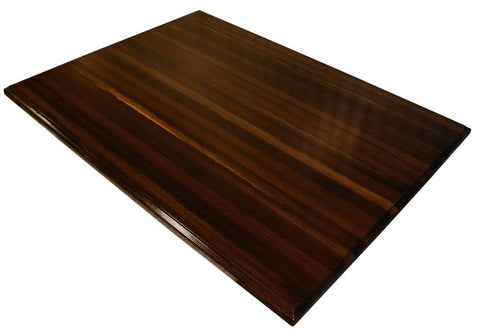
GOOD QUALITIES:
- Chic dark brown color
- Very dense wood
- Cutting, chopping and pulverizing is OK
- Easier to install than stone
- Can tolerate standing water for short periods
- Can have small issues sanded out
- OK for direct contact with food
- Can have integral details like trash chutes and drain boards
- Fairly expensive material
- Needs oiling quarterly
- Can get visible marks from knives and miscellaneous use
- Needs cleaning without chemicals
- Shows dust and crumbs
- Stains from stove-top spatters if not oiled or sealed
TEAK $$


GOOD QUALITIES:
- Dense wood
- Can be resin-sealed
- Pulverizing food is fine
- Easier to install than stone
- Can tolerate limited standing water when not sealed
- Can have small issues sanded out
- Warm color, can be stained various colors too
- Easier to install than stone
- OK for direct contact with food
- Can have integral details like trash chutes and drain boards
- Stains easily
- Needs oiling several times a year when not resin-sealed
- Can get visible marks from knives and miscellaneous use
- Not good for pastry making
- Needs special cleaning
- Stains easily from stove-top spatters when not resin-sealed
IROKO $$$
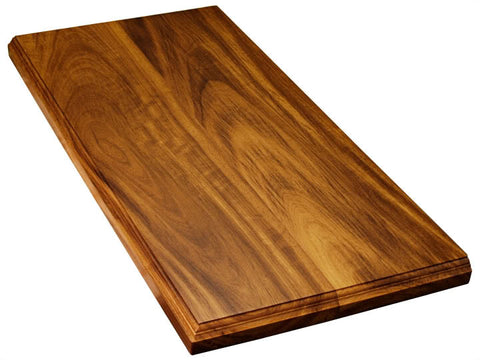

GOOD QUALITIES:
- Dense and durable wood
- Gorgeous graining
- Chopping, cutting and pulverizing food is fine
- Easier to install than stone
- Can tolerate limited standing water when not sealed
- Can have small issues sanded out
- Warm tiger-striped colors with broad boards
- Easier to install than stone
- OK for direct contact with food
- Can have integral details like trash chutes and drain boards
BAD QUALITIES:
- Needs oiling several times a year
- Can get visible marks from knives and miscellaneous use
- Needs special cleaning
- Stains easily from stove-top spatters when not resin-sealed

GOOD QUALITIES
- Looks very exotic and adds character to a room
- Maintains beautiful color when oiled
- Coordinates with most other other wood accents
- Can be resin-sealed
- Feels good to the touch
- Temperate
- Dense durable wood
- Nice on bars or in butler’s pantries for a pop of interest
- Easier to install than stone
- OK for direct contact with food
- Can have integral details like trash chutes and drain boards
BAD QUALITIES
- Cannot tolerate standing water for very long
- Needs oiling quarterly
- Can get visible marks from knives and miscellaneous use
- Needs cleaning without chemicals
- Stains easily from stove-top spatters when not resin-sealed
METAL
STAINLESS STEEL $$$
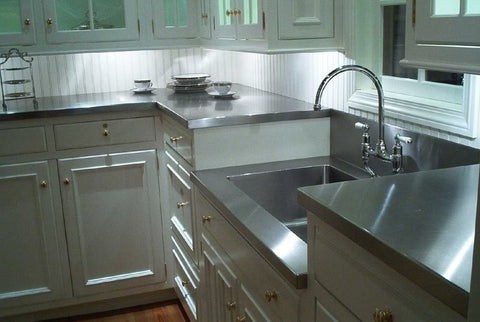

GOOD QUALITIES
- Timeless look
- Easy cleaning
- OK for cutting, chopping and pulverizing
- Tolerates extreme temperatures
- OK for direct contact with food
- Can be cooled with special element for pastry making
- Can have many integral details like trash chutes and drain-boards
- Can have integral sinks and range tops
- Impervious to everything
- OK for stove spatters and standing water
- Can have integral drip-proof edge
- Cold feeling, industrial looking unless handled carefully
- Shows fingerprints until it becomes patinated
- Slippery
COPPER $$$$$

GOOD QUALITIES
- OK for cutting, chopping and pulverizing
- Can have many integral details like trash chutes and drain-boards
- Can have integral sinks
- Impervious to everything
- OK for stove spatters and standing water
- Good for bar tops
- Tolerates standing water
- Tolerates extreme temperatures
- Many choices of textural finishes
- Finish colors from blackened and softly aged to brightly polished
- Very expensive
- Not good for direct contact with some foods
- Stains easily unless lacquered
- Needs polishing if not lacquered
- Will scratch
- Shows under-cabinet light reflections (depending on texture)
- Makes hands smell metallic when working on it
MAN-MADE MATERIALS
QUARTZ $$$ (Cambria, Silestone, Caesarstone)


GOOD QUALITIES
- Harder than granite
- Can be honed or polished
- Seams together better than marble
- Keeps shine indefinitely
- Totally temperature tolerant
- OK to cut, chop and pulverize on it
- Can be cooled with special element for pasty making
- Hides crumbs and dust flecks
- OK for direct contact with food
- Can have integral details like trash chutes and drain boards
- OK for stove spatters
- Tolerates standing water
- Can have custom edge details
- Material is warranted
- Impervious to stains
- Anti-bacterial as it's non-porous
- 100% maintenance free
- Come in a wide range of colors- some even looking like granite.
- Some of the patterns are hideous
CEMENT $$$$


GOOD QUALITIES
- Completely customizable, endless possibilities
- Can have decorative 2-dimensional edges and details
- Can be a custom art piece depending on fabricator
- Comes in many coloration's, textures and finishes
- No seaming (usually)
- Totally heat resistant
- Can pulverize on it
- Hides crumbs and dust flecks
- Extremely durable
- Can have integral patterns and designs, inserts of tiles, glass, etc.
- OK for direct contact with food
- Can have many integral details like trash chutes and drain boards
- Tolerates standing water
- Needs sealing as its porous
- Can get visible marks from knives and miscellaneous use
- Can stain from stove-top spatters
- Can chip
- Can etch from citrus and acidic foods
- More breakage with china and glassware
- Noise reflecting
- Harder to match because of custom colors
TILE $ - $$


GOOD QUALITIES:
- Can be very inexpensive
- Can be done by homeowner
- Impervious surface
- Can add old-world charm
- Heat resistant
- OK for cutting and chopping
- OK for direct contact with food
- Impervious to everything
- OK for stove spatters
- Dirty grout-lines
- Can crack if something heavy is dropped on it
- Cannot tolerate standing water very long (plywood substrate may swell and tiles will lose adherence. Always use cement board under tile counters - not plywood)
- Edges are susceptible to breakage from being bumped
SOLID SURFACE $$$ (Corian, HiMacs, Staron, Avonite)


GOOD QUALITIES
- Invisible seams
- Keeps sheen indefinitely
- OK to cut, chop, pulverize on it
- Available in hundreds of colors and patterns
- Extremely durable
- OK for direct contact with food
- Can have integral details like trash chutes and drain boards
- Can have integral sinks
- Impervious to almost everything
- OK for stove spatters
- Tolerates standing water
- Many custom edge details
- Material is warranted
- Can be repaired on-site
- Only the pure dense white colors are attractive
- Looks like grit infused plastic
So, just DON'T do any of the patterns or faux-stone ones. Got it?
LAMINATE $ (Wilsonart, Formica, Maica, Laminart)


GOOD QUALITIES
- Price
- Keeps sheen indefinitely
- Moderately heat resistant
- Hundreds of colors and patterns from several suppliers
- Extremely durable
- OK for direct contact with food
- Impervious to everything
- OK for stove spatters
- Tolerates standing water for brief times
- Dozens of edge details, bullnose, metal and decorative
- Material is warranted
- Has many patterns that hide dust, crumbs, etc.
- Can be a fun use of color in a space
- Easy and inexpensive to replace
- Comes in textures, variable sheen's and solid color-core
- Cannot chop on it
- Cannot put cast iron pans on it directly from stove
MISCELLANEOUS DETAILS
YOU SHOULD KNOW!
THICKNESSES
3/4" (2 cm) Least expensive. Good for back-splashes
1-1/4" (3 cm) Slightly more expensive. Preferable for countertops.
EDGE DETAILS
Single thickness, 3/4" (2cm)

Double laminated edges using 3/4" (2cm) to look like 3cm material.

Artistic edges using 3/4" (2cm) material to look like 2-1/4" (4cm) material.

FINISHES
- Polished: A smooth, reflective finish. The polished stone finish brings out the rich colors of the stone and enhances natural pattern and veining.
- Flamed: A rough granite finish that highlights the sparkling crystals of granite (usually for outdoor use).
- Honed: A smooth but non-reflective finish that brings out the natural colors and variations of the stone. Lighter in color than polished.
- Velvet: Lightly textured stone finish.
- Under-Mount Sink: (BEST!) Mounted underneath the counter-top, with no visible rim above the top. Water, crumbs and waste can be simply wiped into the sink. Cannot be used with laminate tops.
- Self-Rimming Sink: A sink which is "dropped in" from the top and has a large lip that surrounds the sink above the counter. Less desirable as it creates a barrier around the sink and can trap water and food particles under its edge. The appropriate sink for laminate tops.
- Farm Sink: (way overdone!!) A sink which is accommodated by the counter-top being cutaway and the front of the bowl is exposed to the room.
- Integral Sink: A sink which is made of the same material as the counter-top and has a seamless connection from counter-top into sink bowl (stainless, copper, solid-surface).
HOLES FOR FAUCETS
The fewer the better, one is best SEAMING.
Make sure the installer doesn't seam the tops in front of the sink if he can. You want all seams, if any, in obscure places. Ask the installer to show you a seaming diagram before you agree to the purchase.
BACK-SPLASHES
- If you have black tops black backsplashes will create a very dark, shadowy work-area; consider another material in another color.
- If you have stainless tops you may want to consider another material to soften/balance the industrial look of the tops.
INTEGRAL DRAINBOARDS:
STAINLESS STEEL
STAINLESS STEEL

CEMENT
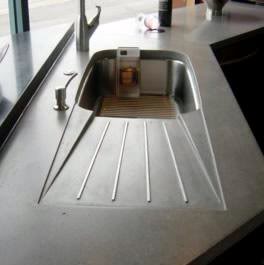
WOOD

LIMESTONE
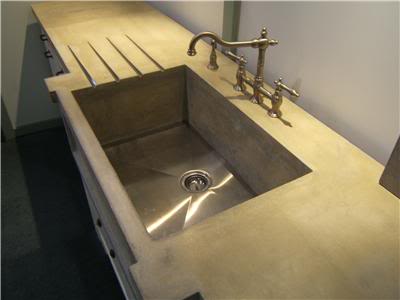
CURBS
The good thing about an elevated bar which is attached to an island or peninsula is that it blocks visually the mess and small appliances from the rest of the room (unless you're sitting at that counter). It's a nice buffer from the breakfast room or family room.
This stunning blue marble backsplash "curb" hides the sink and clutter around it from the rest of the room.

EDGE DETAILS
Copper finished with aged square nailhead trim.

This edge treatment on this granite island is a tad over the top and very 2005. It's just too schmaltzy, regardless of material.
SPECIAL ADDITIONS
A custom knife holder made into the wooden top is a good idea. But, I don't know that I'd like to reach across a hot stove for a knife, but the concept is good.

This kitchen is a bit over the top with the mirrors and chandelier but I do love that island top. The parquet inlaid wood with the Carrera marble insert around the sink is awesome and practical (wonder if the marble is slightly canted toward the sink, which would be smart).

I've always wanted a Trash Chute cut into to top of my counter, then there's no pulling out the bin or moving wet garbage to the bin, you simply drop or swipe it in...next house I guess...

Copper finished with aged square nailhead trim.

This edge treatment on this granite island is a tad over the top and very 2005. It's just too schmaltzy, regardless of material.
SPECIAL ADDITIONS
A custom knife holder made into the wooden top is a good idea. But, I don't know that I'd like to reach across a hot stove for a knife, but the concept is good.

This kitchen is a bit over the top with the mirrors and chandelier but I do love that island top. The parquet inlaid wood with the Carrera marble insert around the sink is awesome and practical (wonder if the marble is slightly canted toward the sink, which would be smart).

I've always wanted a Trash Chute cut into to top of my counter, then there's no pulling out the bin or moving wet garbage to the bin, you simply drop or swipe it in...next house I guess...


